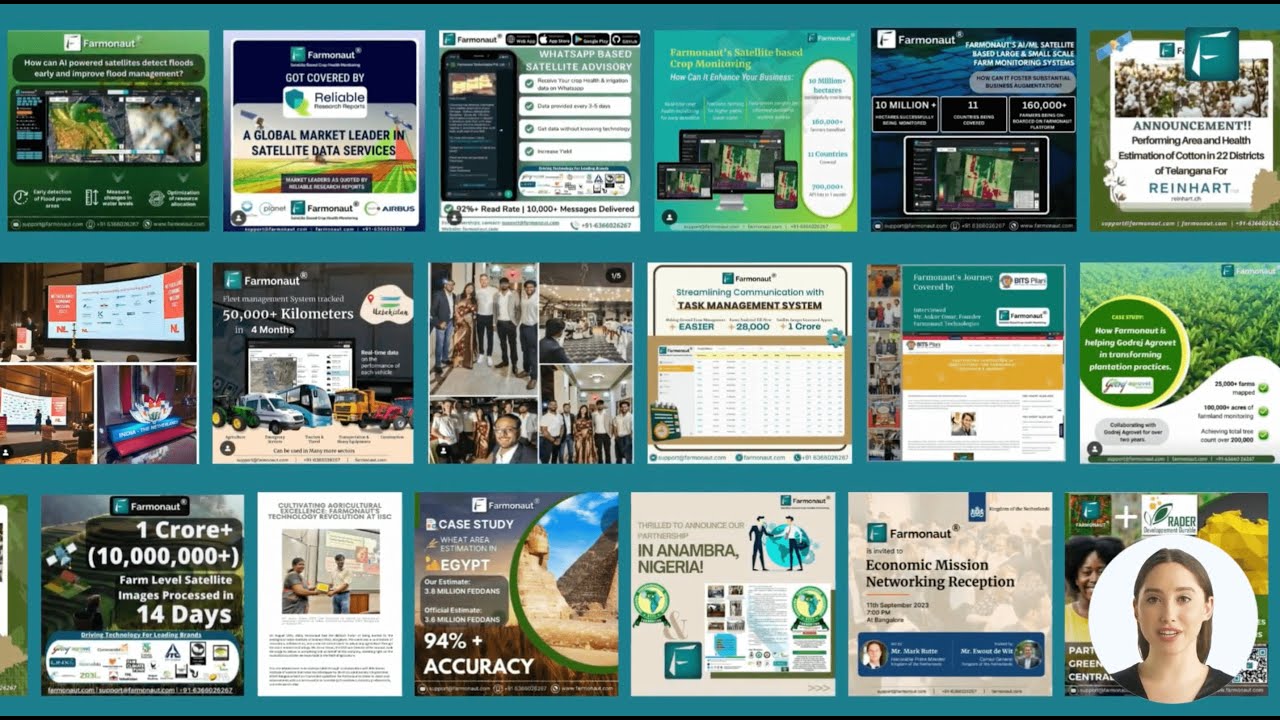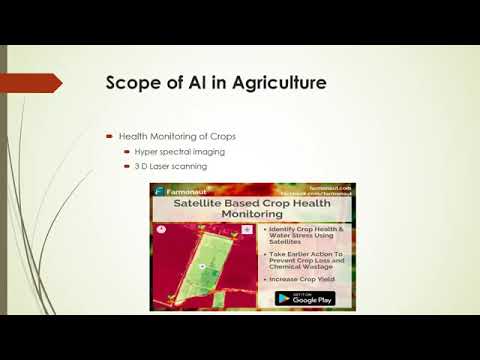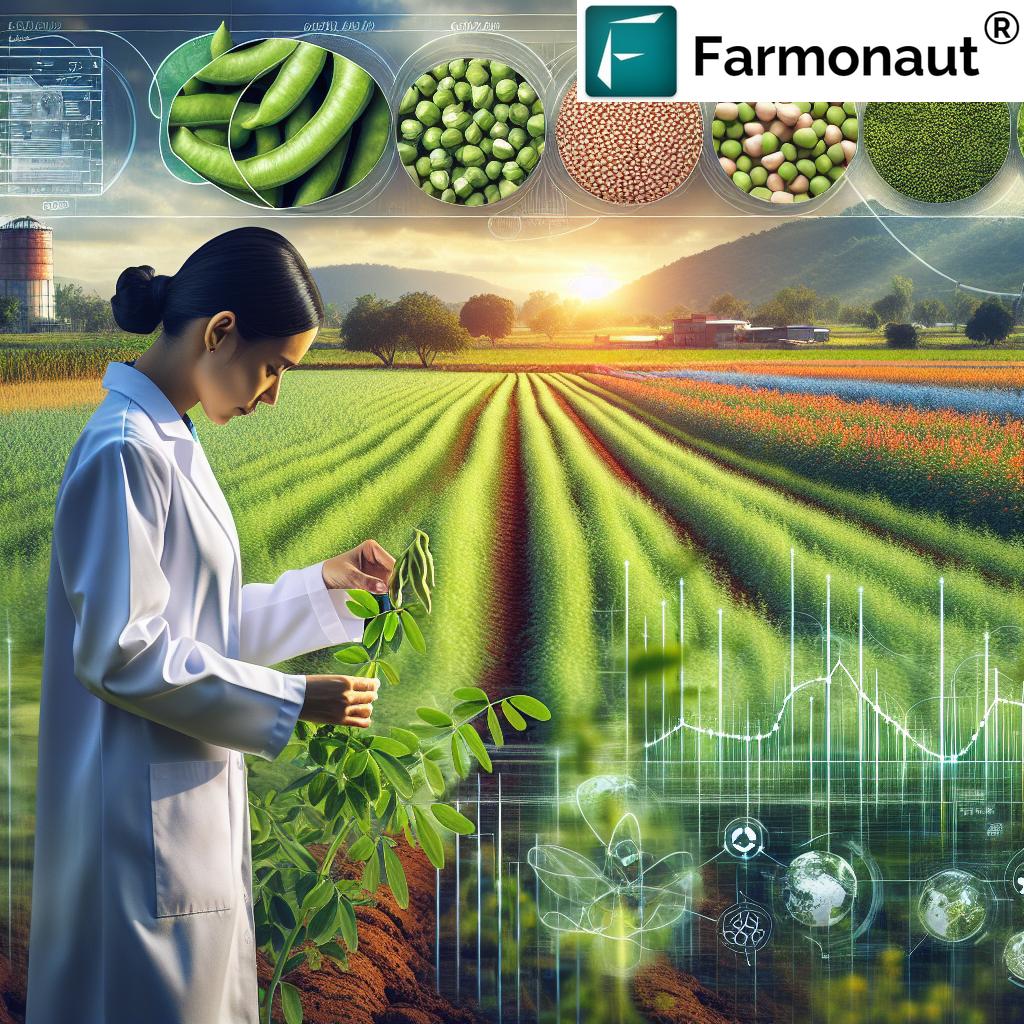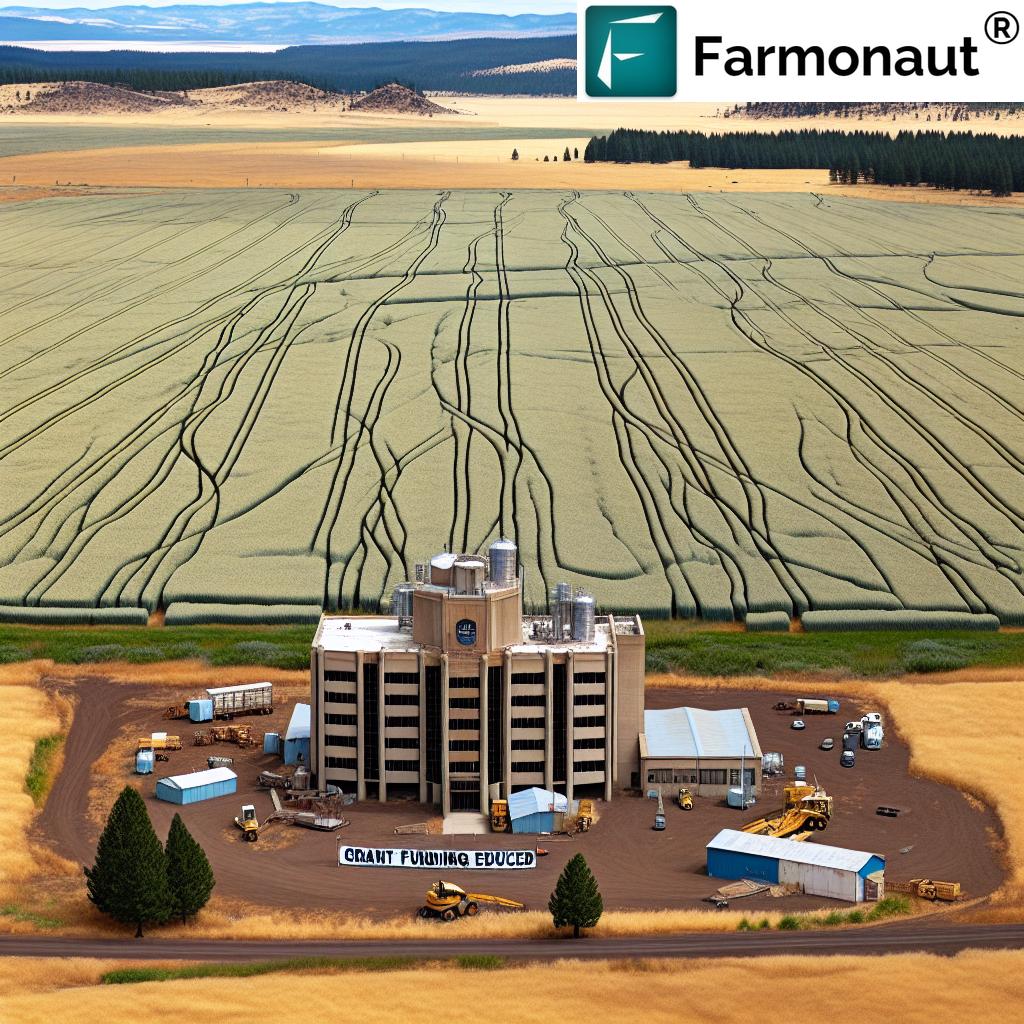2024 U.S. Cattle Industry Outlook: Farmonaut’s Analysis of Market Trends and Weather Impacts on Profitability
“In 2024, U.S. cattle inventories are declining while average prices are rising, impacting herd expansion efforts.”
As we look ahead to the 2024 U.S. cattle industry outlook, we find ourselves at a pivotal moment in agricultural history. The interplay of market trends, weather patterns, and technological advancements is reshaping the landscape of cattle production and profitability. At Farmonaut, we’re committed to providing cutting-edge agricultural data analytics to help producers navigate these complex dynamics. In this comprehensive analysis, we’ll explore the key factors influencing the cattle market, the impact of weather conditions, and the role of precision agriculture technology in shaping the industry’s future.
Market Trends and Economic Factors
The cattle industry is experiencing significant shifts as we move into 2024. Let’s break down the primary market trends and economic factors that are shaping the outlook:
- Declining Inventories: U.S. cattle inventories are on a downward trend, with the total number of head expected to decrease further in 2024. This reduction in supply is a key driver of market dynamics.
- Rising Average Prices: As a direct result of the tightening supply, cattle prices are averaging higher. This trend is expected to continue into 2024, presenting both opportunities and challenges for producers.
- Herd Expansion Challenges: Despite favorable prices, herd expansion efforts are facing obstacles. Weather conditions, particularly drought in key production areas, and economic factors such as higher input costs are constraining growth.
- Consumer Demand: The protein market remains strong, with consumer demand for beef holding steady. However, economic uncertainties and inflationary pressures may influence purchasing patterns.
These market trends underscore the importance of data-driven decision-making in the cattle industry. Farmonaut’s agricultural data analytics platform provides real-time insights that can help producers optimize their operations in response to these dynamic market conditions.
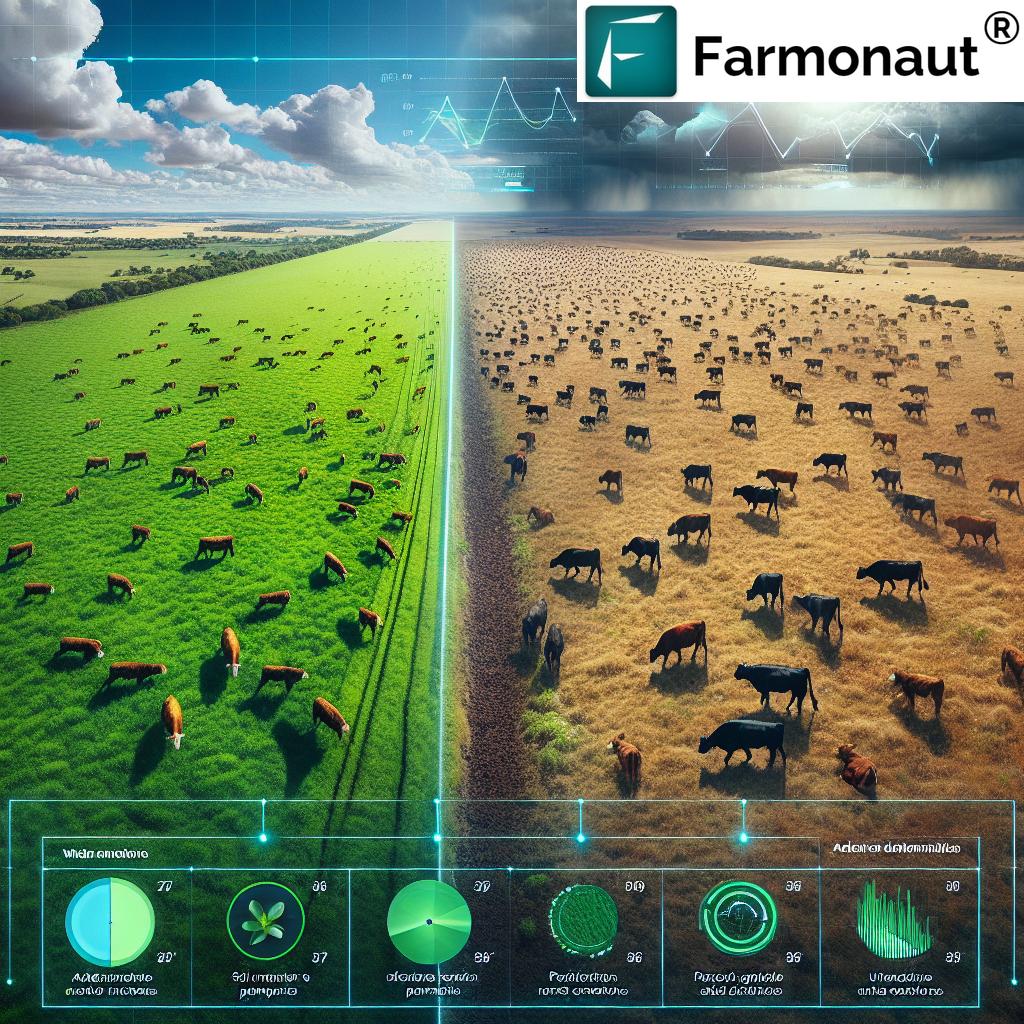
Weather Impacts on Cattle Production
Weather conditions play a crucial role in shaping the cattle industry’s profitability. As we look towards 2024, several key weather-related factors are influencing production:
- El Niño and La Niña Effects: These global weather patterns have significant impacts on agricultural regions across the U.S. El Niño typically brings wetter conditions to the Southern Plains and drier weather to the Northern Plains, while La Niña often results in drier conditions in the South and wetter weather in the North.
- Drought Conditions: Persistent drought in key cattle-producing regions has been a major concern. It affects pasture conditions, hay production, and water availability, all of which are critical for cattle health and growth.
- Soil Moisture Levels: Adequate soil moisture is essential for forage production. Variability in soil moisture across different regions can lead to disparities in feed availability and quality.
- Extreme Weather Events: Increased frequency of extreme weather events, such as heatwaves or severe storms, can pose risks to cattle health and infrastructure.
To address these weather-related challenges, producers are turning to advanced technologies for support. Farmonaut’s satellite-based farm management solutions offer valuable tools for monitoring soil moisture, crop health, and weather patterns, enabling farmers to make informed decisions about resource management and risk mitigation.
Precision Agriculture Technology and Sustainable Farming Practices
“El Niño and La Niña weather patterns significantly influence agricultural regions, affecting crop yields and cattle production.”
The adoption of precision agriculture technology and sustainable farming practices is becoming increasingly crucial for the cattle industry’s long-term profitability and resilience. Here’s how these advancements are shaping the sector:
- Satellite-Based Monitoring: Farmonaut’s platform utilizes satellite imagery to provide real-time data on pasture conditions, crop health, and land use. This information helps ranchers optimize grazing patterns and feed production.
- AI-Driven Advisory Systems: Our Jeevn AI system offers personalized recommendations based on real-time data, helping producers make informed decisions about herd management, feed optimization, and resource allocation.
- Soil Moisture Monitoring: Advanced soil moisture sensors and satellite-based measurements allow for precise irrigation management, crucial for maintaining pasture quality and crop yields for feed production.
- Climate-Smart Agriculture: By integrating weather forecasts and historical climate data, farmers can implement climate-smart practices that enhance resilience to weather variability.
These technological advancements are not just improving efficiency; they’re also contributing to more sustainable farming practices. By optimizing resource use and reducing waste, precision agriculture technology is helping the cattle industry reduce its environmental footprint while improving profitability.
Economic Outlook and Profitability Factors
As we analyze the economic outlook for the cattle industry in 2024, several key factors emerge that will influence profitability:
- Input Costs: Rising prices for feed, fuel, and labor continue to pressure profit margins. Efficient resource management becomes crucial.
- Interest Rates: Higher interest rates may impact financing options for herd expansion and operational investments.
- Global Trade: Export demand for U.S. beef remains a significant factor in overall market stability and price support.
- Production Efficiency: Adopting technologies that improve feed conversion ratios and overall herd health can significantly impact the bottom line.
To navigate these economic challenges, producers are increasingly turning to data-driven solutions. Farmonaut’s agricultural data analytics provide valuable insights into market trends, helping farmers make informed decisions about production levels, timing of sales, and resource allocation.
Comparative Analysis: 2024 U.S. Cattle Industry Outlook
| Factor | 2023 Status | 2024 Projection | Impact on Profitability |
|---|---|---|---|
| Average Cattle Prices | Moderate | Increasing (+5-10%) | High Positive |
| Herd Inventory | Declining | Further Decline (-2-3%) | Moderate Positive |
| El Niño/La Niña Effects | Moderate El Niño | Transition to Neutral | Moderate Positive |
| Soil Moisture Levels | Variable | Improving in Some Regions | Moderate Positive |
| Adoption of Precision Agriculture Technologies | Growing | Accelerating (+15-20%) | High Positive |
This comparative analysis highlights the complex interplay of factors shaping the cattle industry’s outlook for 2024. While challenges persist, opportunities for increased profitability emerge through strategic management and technology adoption.
Regional Variations and Market Dynamics
The U.S. cattle industry is characterized by significant regional variations, each with its unique challenges and opportunities:
- Southern Plains: Drought recovery and water management remain critical issues. Farmonaut’s soil moisture monitoring tools can aid in efficient resource allocation.
- Midwest: Corn Belt producers face decisions between crop production and cattle feeding. Our crop yield optimization tools can help inform these choices.
- Northern Plains: Cold stress and feed efficiency are key concerns. Precision agriculture technology can assist in optimizing winter feeding strategies.
- Southeast: Heat stress management and forage production are priorities. Satellite-based vegetation health monitoring can guide pasture management decisions.
Understanding these regional dynamics is crucial for producers and industry stakeholders. Farmonaut’s platform provides localized insights that can help tailor strategies to specific geographic conditions.

Technological Innovations Shaping the Future
As we look towards the horizon of cattle production, several technological innovations are poised to transform the industry:
- Blockchain-Based Traceability: Farmonaut’s blockchain solutions are enhancing supply chain transparency, crucial for meeting consumer demands for product origin information.
- Carbon Footprint Monitoring: Our carbon footprinting tools help producers measure and manage their environmental impact, potentially opening new revenue streams through carbon credits.
- Advanced Weather Forecasting: Integration of high-resolution weather data with farm management software allows for more precise planning and risk mitigation.
- Automated Feeding Systems: AI-driven feeding systems can optimize nutrition based on real-time animal health data and market conditions.
These innovations are not just improving efficiency; they’re reshaping the very nature of cattle production. By leveraging Farmonaut’s suite of agtech solutions, producers can stay at the forefront of these industry-changing developments.
Sustainability and Consumer Trends
Sustainability is increasingly becoming a focal point in the cattle industry, driven by both consumer demand and environmental considerations:
- Regenerative Grazing: Practices that improve soil health and carbon sequestration are gaining traction. Farmonaut’s vegetation health monitoring can support these efforts.
- Water Conservation: Efficient water use is critical, especially in drought-prone regions. Our soil moisture monitoring tools aid in precision irrigation.
- Methane Reduction: Innovations in feed additives and manure management are addressing greenhouse gas emissions. Data analytics can help measure the effectiveness of these strategies.
- Consumer Preferences: Growing interest in sustainably produced beef is influencing market dynamics. Traceability solutions can help producers meet these consumer demands.
By aligning production practices with these sustainability trends, cattle producers can not only meet consumer expectations but also potentially access premium markets and improve long-term profitability.
Risk Management and Financial Planning
In an industry characterized by volatility, effective risk management and financial planning are essential. Here’s how data-driven approaches can help:
- Market Forecasting: Utilizing big data and AI, Farmonaut’s platform can provide insights into potential market movements, aiding in timing decisions for buying and selling.
- Weather Risk Mitigation: Our advanced weather forecasting capabilities help producers prepare for and respond to adverse weather conditions.
- Cost Optimization: By analyzing input costs and production efficiency, our tools can identify areas for potential savings and improved profitability.
- Strategic Planning: Long-term data trends can inform decisions about herd expansion, infrastructure investments, and diversification strategies.
Integrating these risk management tools into farm operations can significantly enhance financial stability and long-term success in the cattle industry.
Global Market Influences
The U.S. cattle industry operates within a global context, influenced by international trade dynamics and global protein demand:
- Export Markets: Demand from key markets like Japan, South Korea, and China significantly impacts U.S. beef prices. Monitoring global economic trends is crucial.
- Competition: Production levels in major beef-exporting countries like Brazil and Australia can affect global supply and U.S. market opportunities.
- Trade Policies: International trade agreements and tariffs can quickly shift market access. Staying informed on policy changes is essential for strategic planning.
- Global Protein Demand: Rising incomes in developing countries are increasing demand for high-quality protein sources, presenting opportunities for U.S. beef exports.
Farmonaut’s global agricultural market trends analysis can provide valuable insights into these international dynamics, helping U.S. producers position themselves effectively in the global marketplace.
Adapting to Climate Change
Climate change presents both challenges and opportunities for the cattle industry. Here’s how producers can adapt:
- Resilient Breed Selection: Choosing cattle breeds adapted to changing climate conditions can improve herd resilience.
- Diversification: Incorporating diverse forage species can enhance pasture resilience to variable weather patterns.
- Water Management: Implementing efficient irrigation systems and water storage solutions is crucial in areas facing increased drought risk.
- Heat Stress Mitigation: Investing in shade structures and cooling systems can protect cattle productivity in warmer regions.
Farmonaut’s climate-smart agriculture tools can assist producers in implementing these adaptive strategies, ensuring long-term sustainability and profitability.
The Role of Data in Modern Cattle Production
In today’s rapidly evolving agricultural landscape, data has become a critical asset for cattle producers. Here’s how Farmonaut’s data-driven solutions are transforming the industry:
- Predictive Analytics: By analyzing historical data and current trends, our AI models can forecast potential challenges and opportunities, allowing for proactive management.
- Performance Optimization: Detailed tracking of herd performance metrics enables producers to identify top-performing animals and refine breeding programs.
- Resource Allocation: Data-driven insights help optimize the use of feed, water, and other inputs, reducing waste and improving efficiency.
- Decision Support: Our comprehensive dashboards provide at-a-glance information on key performance indicators, supporting informed decision-making.
By leveraging the power of data, cattle producers can transform challenges into opportunities, ensuring a profitable and sustainable future for their operations.
Conclusion: Navigating the Future of U.S. Cattle Production
As we look ahead to 2024 and beyond, the U.S. cattle industry stands at a crossroads of challenge and opportunity. The convergence of market trends, weather impacts, and technological advancements is reshaping the landscape of cattle production and profitability. By embracing precision agriculture technology, sustainable farming practices, and data-driven decision-making, producers can navigate these complex dynamics and position themselves for long-term success.
Farmonaut remains committed to supporting the cattle industry through this evolution. Our advanced agricultural data analytics, satellite-based monitoring tools, and AI-driven insights empower producers to optimize their operations, mitigate risks, and capitalize on emerging opportunities. As we face the uncertainties of changing weather patterns, market fluctuations, and evolving consumer preferences, the power of information becomes increasingly crucial.
The 2024 outlook presents a picture of an industry in transition – one where innovative technologies and sustainable practices are not just advantageous but essential for profitability. By staying informed, adaptable, and technologically empowered, U.S. cattle producers can turn challenges into opportunities, ensuring a resilient and prosperous future for the industry.
FAQ Section
Q: How will declining cattle inventories affect market prices in 2024?
A: Declining inventories are expected to support higher average cattle prices in 2024, as reduced supply typically leads to increased market values. However, this may be moderated by factors such as consumer demand and global trade dynamics.
Q: What role does precision agriculture play in improving cattle production efficiency?
A: Precision agriculture technologies, such as those offered by Farmonaut, play a crucial role in optimizing resource use, monitoring herd health, and improving overall production efficiency. These tools provide real-time data and insights that enable producers to make informed decisions about feeding, grazing, and herd management.
Q: How can producers mitigate the impacts of extreme weather events on their operations?
A: Producers can mitigate weather impacts by utilizing advanced weather forecasting tools, implementing climate-smart agricultural practices, and leveraging data analytics to make proactive management decisions. Farmonaut’s platform offers satellite-based monitoring and AI-driven insights to help producers prepare for and respond to weather challenges.
Q: What are the key factors influencing profitability in the cattle industry for 2024?
A: Key factors include market prices, input costs (especially feed and energy), weather conditions, global trade dynamics, and adoption of efficiency-improving technologies. Producers who can effectively manage these factors through data-driven decision-making are likely to see improved profitability.
Q: How is consumer demand for sustainable beef production affecting the industry?
A: Growing consumer interest in sustainably produced beef is driving changes in production practices and creating opportunities for producers who can demonstrate environmental stewardship. This trend is influencing market dynamics and potentially opening premium market segments for sustainably raised cattle.
For more information on how Farmonaut can help you optimize your cattle production and navigate the complexities of the 2024 market, visit our website or download our app:
For developers interested in integrating our agricultural data analytics into their own applications, check out our API and API Developer Docs.



